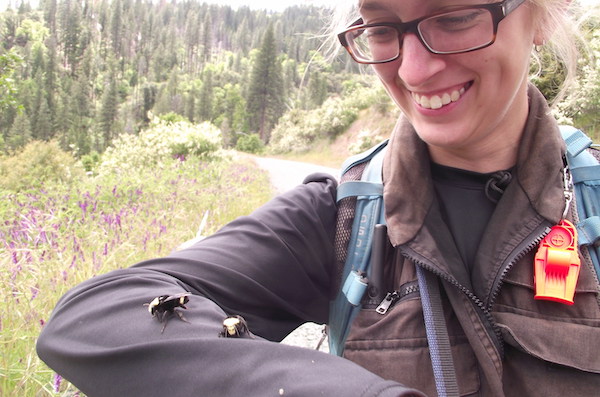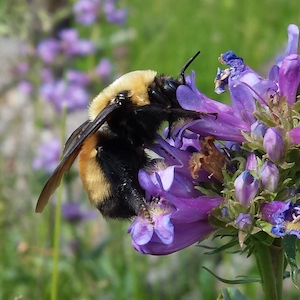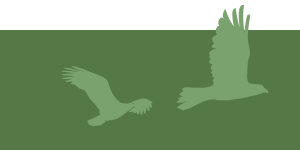
POLLINATOR ECOLOGY AND CONSERVATION

Wildlife species that pollinate flowers provide critical ecosystem services that are disproportionately important compared to the diminutive size of many of the pollinators. Alarmingly, populations of many pollinators in the Sierra Nevada and around the world are declining, including various native bumble bee species.
For instance, the western bumble bee (Bombus occidentalis) was recently designated by the US Forest Service as a Sensitive Species on National Forests in California, in part due to apparent disappearance from much of its historical range in recent years. In response, IBP has initiated multiple studies of bumble bee ecology in the Sierra Nevada.
Another important pollinator in the Sierra Nevada, the Rufous Hummingbird, still occurs in large numbers across the mountain range during its summertime southbound migration, but is increasingly recognized as a bird species in trouble, with a population estimated to be declining by 3% per year.
For more information about IBP’s efforts to study and protect pollinators in the Sierra Nevada, please contact Helen Loffland.

Photo Credits: Top of Page, IBP; Bottom Left Column (western bumble bee painting), Lauren Helton; Right Column, Travis DuBridge
CONSERVATION IMPLICATIONS
Bumble bees are declining across many regions in the Northern Hemisphere, indicating a need to manage, protect, and enhance their habitats. IBP's work on Sierra Nevada bumble bees focuses on their habitat needs in mountain meadows, riparian areas, and other habitats. We use non-lethal sampling techniques to capture, identify and release bees.

A study we published in 2020 determined the flower species favored by various bumble bee species in the Plumas National Forest. We found that each of the more common bumble bee species selected a different assortment of flowers. The US Forest Service is already using the results of this study to identify and prioritize bumble bee habitat in need of restoration. In addition, Forest Service personnel are working to include the favored flower species in seed mixes and propagated plants used in restoration following wildfire and other disturbances.
IBP's work on pollinators is making bumble bee conservation efforts in the Sierra Nevada more effective by providing specific, science-based recommendations for habitat management and restoration.
SELECTED PUBLICATIONS
Peer-reviewed Publications
Cole, J.S, H.L. Loffland, C.E. Looney, and R.B. Siegel. 2025. Mechanical thinning and prescribed fire benefit bumble bees and butterflies in a northern California conifer forest. Forest Ecology and Management 588:122758. PDF
Cole, J.S., R.B. Siegel, H.L. Loffland, E.A. Elsey, M.W. Tingley, and M. Johnson. 2020. Plant selection by bumble bees (Hymenoptera: Apidae) in montane riparian habitat of California. Environmental Entomology 49:220–229. PDF
Graves, T.A., W.M. Janousek, S.M. Gaulke, A.C. Nicholas, D.A. Keinath, C.M. Bell, S. Cannings, R.G. Hatfield, J.M. Heron, J.B. Koch, H.L. Loffland, L.L. Richardson, A.T. Rohde, J. Rykken, J.P. Strange, L.M. Tronstad, and C.S. Sheffield. 2020. Western bumble bee: declines in the continental United States and range-wide information gaps. Ecosphere 11:e03141. PDF
Cole, J.S., R.B. Siegel, H.L. Loffland, M.W. Tingley, E.A. Elsey, and M. Johnson. 2019. Explaining the birds and the bees: deriving habitat restoration targets from multi-species occupancy models. Ecosphere 10:e02718. PDF
Sieburth, D., and P. Pyle. 2018. Evidence for a prealternate molt-migration in the Rufous Hummingbird and its implications for the evolution of molts in Apodiformes. The Auk: Ornithological Advances 135:495-505. PDF
Loffland, H.L., J.S. Polasik, M.W. Tingley, E.A. Elsey, C. Loffland, G. Lebuhn, and R.B. Siegel. 2017. Bumble bee use of post-fire chaparral in the central Sierra Nevada. The Journal of Wildlife Management 81:1084-97. For a copy of this publication, please contact Helen Loffland.
Other Publications and Reports
Loffland, H. 2021. Using birds and bumble bees to inform meadow restoration at Carpenter Valley. IBP report to Truckeee River Watershed Council.
Loffland, H. 2021. Using birds and bumble bees to inform meadow restoration at Sardine Valley. IBP report to Truckee River Watershed Council.
Loffland, H.L., R.B. Siegel, and J.S. Cole. 2021. Response of bumble bees to postfire shrub removal treatments on Eldorado National Forest. The Institute for Bird Populations, Petaluma, CA. PDF
Loffland, H. 2020. Willow Flycatcher surveys to inform meadow restoration success at Bean Meadow. The Institute for Bird Populations, Petaluma, CA.
Loffland, H. and R.B. Siegel. 2019. Assessing bumble bee communities on the Power Fire of the Eldorado National Forest: report for the 2018 field season. The Institute for Bird Populations, Point Reyes Station, CA.
The Institute for Bird Populations. 2017. Bumble bees and post-fire chaparral management in the Sierra Nevada. Color brochure, 8 pp. PDF
Polasik, J.S., H.L. Loffland, R.B. Siegel, and M.W. Tingley. 2016. Assessing bumble bee communities on the Fred’s and Power Fires of the Eldorado National Forest: report for the 2015 Field Season. The Institute for Bird Populations, Point Reyes Station, CA. PDF








